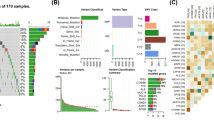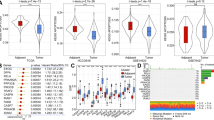Abstract
Purpose
TRP channels have been implicated in cancer progression. Our study seeks to establish a prognostic model for hepatocellular carcinoma (HCC) by utilizing genes related to TRP channels.
Methods
We used the TCGA and ICGC databases as training and validation cohorts, respectively. We calculated the risk scores using Lasso–Cox regression analysis based on the expression levels of prognostic genes and performed survival analysis to compare overall survival between high- and low-risk groups. Then we compared the clinicopathologic characteristics and conducted biological functional analysis. We also explored immune cell infiltration and compared the drug sensitivity.
Results
Using bioinformatics algorithms, we identified 11 TRP-related genes and calculated the risk scores. Patients in the high-risk group demonstrated worse overall survival, as well as more advanced T stage and pathologic stage. The risk score showed a significant association with the cell cycle. The high-risk group had more ICI and RTK targets with elevated expression and showed better therapeutic effect to chemotherapy including 5-fluorouracil, camptothecin, docetaxel, doxorubicin, gemcitabine, and paclitaxel. Overall, an individualized nomogram was constructed by integrating the risk score and requisite clinicopathologic parameters to predict the overall survival of HCC patients.
Conclusions
We successfully established a highly accurate prognostic model for predicting overall survival and therapeutic effects using TRP channel-related genes.
Similar content being viewed by others
Avoid common mistakes on your manuscript.
Introduction
Primary liver cancer is globally recognized as the sixth most common cancer type and ranks as the third most common cause of cancer-related mortality (Sung et al. 2021). Hepatocellular carcinoma (HCC) is the most prevalent primary liver cancer and typically arises in the context of chronic liver disease caused by hepatitis B or C virus infection, alcohol abuse, or metabolic syndrome (Llovet et al. 2016). Although the mortality rate of liver cancer has been increasing for decades, the rates have stabilized during the most recent 5 years in both men and women owing to advances in early detection, surgical techniques, and molecularly targeted therapies (Siegel et al. 2022). Despite advancements in treatment options, the overall survival rate of HCC patients remains unsatisfactory due to recurrent disease, metastasis, and drug resistance. The discovery of new targets is needed to slow down disease progression and improve prognosis.
Transient receptor potential (TRP) channels were initially discovered in a blind strain of Drosophila (Montell and Rubin 1989) and are now recognized as a family of ion channels with versatile functions. Structurally, TRPs are characterized by six transmembrane spanning domains (S1–S6) and are classified into eight families: TRPA (ankyrin), TRPC (canonical), TRPM (melastatin), TRPML (mucolipin), TRPN (NO-mechano-potential), TRPP (polycystin), TRPS (soromelastatin), and TRPV (vanilloid) (Wu et al. 2010; Zhang et al. 2022). Functionally, TRPs are gated by various stimuli, including thermal, pain, mechanical, and chemical inputs and function as intracellular ion channels in cellular organelles such as lysosomes, the Golgi network, and the endoplasmic reticulum (Gees et al. 2010; Himmel and Cox 2020).
During tumor formation and metastasis, abnormal TRP expression has been observed in multiple cancers, which may act as a vital role of promoting the proliferation and metastasis of cancer (Brooks et al. 2010; Chen et al. 2014). We previously demonstrated that TRPV2 knockdown enhances the stemness of cancer stem-like cells through increased expression levels of cancer stem cell markers ALDH1, CD133, and CD44 (Hu et al. The datasets generated during and/or analyzed during the current study are available from the corresponding author on reasonable request. Hepatocellular carcinoma The Cancer Genome Atlas Gene set enrichment analysis False discovery rate Gene ontology Kyoto Encyclopedia of Genes and Genomes Cell-type identification by estimating relative subsets of RNA transcripts Single-sample gene set enrichment analysis Transient receptor potential Tumor mutation burden Immune checkpoint inhibitor Receptor protein tyrosine kinase Protein receptor tyrosine kinase inhibitor Least absolute shrinkage and selection operator International Cancer Genome Consortium Bindea G, Mlecnik B, Tosolini M, Kirilovsky A, Waldner M, Obenauf AC, Angell H, Fredriksen T, Lafontaine L, Berger A, Bruneval P, Fridman WH, Becker C, Pagès F, Speicher MR, Trajanoski Z, Galon J (2013) Spatiotemporal dynamics of intratumoral immune cells reveal the immune landscape in human cancer. Immunity 39(4):782–795. https://doi.org/10.1016/j.immuni.2013.10.003 Brooks SA, Lomax-Browne HJ, Carter TM, Kinch CE, Hall DMS (2010) Molecular interactions in cancer cell metastasis. Acta Histochem 112(1):3–25. https://doi.org/10.1016/j.acthis.2008.11.022 Cai S-H, Lu S-X, Liu L-L, Zhang CZ, Yun J-P (2017) Increased expression of hepatocyte nuclear factor 4 alpha transcribed by promoter 2 indicates a poor prognosis in hepatocellular carcinoma. Therap Adv Gastroenterol 10(10):761–771. https://doi.org/10.1177/1756283X17725998 Callahan MK, Postow MA, Wolchok JD (2016) Targeting T cell co-receptors for cancer therapy. Immunity 44(5):1069–1078. https://doi.org/10.1016/j.immuni.2016.04.023 Chen J, Luan Y, Yu R, Zhang Z, Zhang J, Wang W (2014) Transient receptor potential (TRP) channels, promising potential diagnostic and therapeutic tools for cancer. Biosci Trends 8(1):1–10. https://doi.org/10.5582/bst.8.1 European Association for the Study of the Liver. Electronic address: easloffice@easloffice.eu, European Association for the Study of the Liver (2018) EASL clinical practice guidelines: management of hepatocellular carcinoma. J Hepatol 69(1):182–236. https://doi.org/10.1016/j.jhep.2018.03.019 Finn RS, Qin S, Ikeda M, Galle PR, Ducreux M, Kim T-Y, Kudo M, Breder V, Merle P, Kaseb AO, Li D, Verret W, Xu D-Z, Hernandez S, Liu J, Huang C, Mulla S, Wang Y, Lim HY, Zhu AX, Cheng A-L, IMbrave150 Investigators (2020) Atezolizumab plus bevacizumab in unresectable hepatocellular carcinoma. N Engl J Med 382(20):1894–1905. https://doi.org/10.1056/NEJMoa1915745 Gees M, Colsoul B, Nilius B (2010) The role of transient receptor potential cation channels in Ca2+ signaling. Cold Spring Harb Perspect Biol 2(10):a003962. https://doi.org/10.1101/cshperspect.a003962 Gong Z, Yu J, Yang S, Lai PBS, Chen GG (2020) FOX transcription factor family in hepatocellular carcinoma. Biochim Biophys Acta Rev Cancer 1874(1):188376. https://doi.org/10.1016/j.bbcan.2020.188376 Hänzelmann S, Castelo R, Guinney J (2013) GSVA: gene set variation analysis for microarray and RNA-seq data. BMC Bioinform 14:7. https://doi.org/10.1186/1471-2105-14-7 He M, Li Q, Zou R, Shen J, Fang W, Tan G, Zhou Y, Wu X, Xu L, Wei W, Le Y, Zhou Z, Zhao M, Guo Y, Guo R, Chen M, Shi M (2019) Sorafenib plus hepatic arterial infusion of oxaliplatin, fluorouracil, and leucovorin vs sorafenib alone for hepatocellular carcinoma with portal vein invasion: a randomized clinical trial. JAMA Oncol 5(7):953–960. https://doi.org/10.1001/jamaoncol.2019.0250 Himmel NJ, Cox DN (2020) Transient receptor potential channels: current perspectives on evolution, structure, function and nomenclature. Proc Biol Sci 287(1933):20201309. https://doi.org/10.1098/rspb.2020.1309 Hu Z, Cao X, Fang Y, Liu G, **e C, Qian K, Lei X, Cao Z, Du H, Cheng X, Xu X (2018) Transient receptor potential vanilloid-type 2 targeting on stemness in liver cancer. Biomed Pharmacother 105:697–706. https://doi.org/10.1016/j.biopha.2018.06.029 Koh HH, Choi S, Park C-K, Ha SY (2022) Down-regulation of TRPV6 Is associated with adverse prognosis in hepatocellular carcinoma treated with curative resection. Cancer Genom Proteom 19(2):259–269. https://doi.org/10.21873/cgp.20318 Llovet JM, Di Bisceglie AM, Bruix J, Kramer BS, Lencioni R, Zhu AX, Sherman M, Schwartz M, Lotze M, Talwalkar J, Gores GJ, Panel of Experts in HCC-Design Clinical Trials (2008) Design and endpoints of clinical trials in hepatocellular carcinoma. J Natl Cancer Inst 100(10):698–711. https://doi.org/10.1093/jnci/djn134 Llovet JM, Zucman-Rossi J, Pikarsky E, Sangro B, Schwartz M, Sherman M, Gores G (2016) Hepatocellular carcinoma. Nat Rev Dis Primers 2:16018. https://doi.org/10.1038/nrdp.2016.18 Meléndez B, Van Campenhout C, Rorive S, Remmelink M, Salmon I, D’Haene N (2018) Methods of measurement for tumor mutational burden in tumor tissue. Transl Lung Cancer Res 7(6):661–667. https://doi.org/10.21037/tlcr.2018.08.02 Montell C, Rubin GM (1989) Molecular characterization of the Drosophila trp locus: a putative integral membrane protein required for phototransduction. Neuron 2(4):1313–1323. https://doi.org/10.1016/0896-6273(89)90069-x Newman AM, Liu CL, Green MR, Gentles AJ, Feng W, Xu Y, Hoang CD, Diehn M, Alizadeh AA (2015) Robust enumeration of cell subsets from tissue expression profiles. Nat Methods 12(5):453–457. https://doi.org/10.1038/nmeth.3337 Qin S, Bai Y, Lim HY, Thongprasert S, Chao Y, Fan J, Yang T-S, Bhudhisawasdi V, Kang WK, Zhou Y, Lee JH, Sun Y (2013) Randomized, multicenter, open-label study of oxaliplatin plus fluorouracil/leucovorin versus doxorubicin as palliative chemotherapy in patients with advanced hepatocellular carcinoma from Asia. J Clin Oncol 31(28):3501–3508. https://doi.org/10.1200/JCO.2012.44.5643 Seung E, **ng Z, Wu L, Rao E, Cortez-Retamozo V, Ospina B, Chen L, Beil C, Song Z, Zhang B, Levit M, Deng G, Hebert A, Kirby P, Li A, Poulton E-J, Vicente R, Garrigou A, Piepenhagen P, Ulinski G, Sanicola-Nadel M, Bangari DS, Qiu H, Pao L, Wiederschain D, Wei R, Yang Z-Y, Nabel GJ (2022) A trispecific antibody targeting HER2 and T cells inhibits breast cancer growth via CD4 cells. Nature 603(7900):328–334. https://doi.org/10.1038/s41586-022-04439-0 Sherman M (2008) Recurrence of hepatocellular carcinoma. N Engl J Med 359(19):2045–2047. https://doi.org/10.1056/NEJMe0807581 Siegel RL, Miller KD, Fuchs HE, Jemal A (2022) Cancer statistics, 2022. CA Cancer J Clin 72(1):7–33. https://doi.org/10.3322/caac.21708 Sung H, Ferlay J, Siegel RL, Laversanne M, Soerjomataram I, Jemal A, Bray F (2021) Global cancer statistics 2020: GLOBOCAN estimates of incidence and mortality worldwide for 36 cancers in 185 countries. CA Cancer J Clin 71(3):209–249. https://doi.org/10.3322/caac.21660 Tang B, Zhu J, Zhao Z, Lu C, Liu S, Fang S, Zheng L, Zhang N, Chen M, Xu M, Yu R, Ji J (2021) Diagnosis and prognosis models for hepatocellular carcinoma patient’s management based on tumor mutation burden. J Adv Res 33:153–165. https://doi.org/10.1016/j.jare.2021.01.018 Wu L-J, Sweet T-B, Clapham DE (2010) International Union of Basic and Clinical Pharmacology. LXXVI. Current progress in the mammalian TRP ion channel family. Pharmacol Rev 62(3):381–404. https://doi.org/10.1124/pr.110.002725 Xu J, Yang Y, **e R, Liu J, Nie X, An J, Wen G, Liu X, ** H, Tuo B (2018) The NCX1/TRPC6 complex mediates TGFβ-driven migration and invasion of human hepatocellular carcinoma cells. Cancer Res 78(10):2564–2576. https://doi.org/10.1158/0008-5472.CAN-17-2061 Yasuoka H, Asai A, Ohama H, Tsuchimoto Y, Fukunishi S, Higuchi K (2020) Increased both PD-L1 and PD-L2 expressions on monocytes of patients with hepatocellular carcinoma was associated with a poor prognosis. Sci Rep 10(1):10377. https://doi.org/10.1038/s41598-020-67497-2 Zhang H, Zhang X, Wang X, Sun H, Hou C, Yu Y, Wang S, Yin F, Yang Z (2022) Comprehensive analysis of TRP channel-related genes in patients with triple-negative breast cancer for guiding prognostic prediction. Front Oncol 12:941283. https://doi.org/10.3389/fonc.2022.941283 The authors thank the Department of Hepatobiliary Pancreatic Surgery of South China Hospital Shenzhen University and the contributions from the TCGA and ICGC network. The authors have not disclosed any funding. All authors contributed to the study conception and design. Data collection and analysis were performed by CP and ZX. The first draft of the manuscript was written by CP and all authors commented on previous versions of the manuscript. All authors read and approved the final manuscript. The authors have no relevant financial or non-financial interests to disclose. Springer Nature remains neutral with regard to jurisdictional claims in published maps and institutional affiliations. Below is the link to the electronic supplementary material. Supplementary file2 Figure S2 CIBERSORT analysis of TCGA cohort. (A–B) CIBERSORT analysis of ICGC cohort. (C–D) (PDF 15307 KB) Open Access This article is licensed under a Creative Commons Attribution 4.0 International License, which permits use, sharing, adaptation, distribution and reproduction in any medium or format, as long as you give appropriate credit to the original author(s) and the source, provide a link to the Creative Commons licence, and indicate if changes were made. The images or other third party material in this article are included in the article's Creative Commons licence, unless indicated otherwise in a credit line to the material. If material is not included in the article's Creative Commons licence and your intended use is not permitted by statutory regulation or exceeds the permitted use, you will need to obtain permission directly from the copyright holder. To view a copy of this licence, visit http://creativecommons.org/licenses/by/4.0/. Pang, C., Xu, Z., Han, J. et al. Identification of a TRP channel-related risk model for predicting prognosis and therapeutic effects of patients with hepatocellular carcinoma.
J Cancer Res Clin Oncol 149, 16811–16825 (2023). https://doi.org/10.1007/s00432-023-05394-7 Received: Accepted: Published: Issue Date: DOI: https://doi.org/10.1007/s00432-023-05394-7Data availability
Abbreviations
References
Acknowledgements
Funding
Author information
Authors and Affiliations
Contributions
Corresponding author
Ethics declarations
Conflict of interest
Additional information
Publisher's Note
Supplementary Information
432_2023_5394_MOESM2_ESM.pdf
Rights and permissions
About this article
Cite this article
Keywords




